Related Research Articles

Claterna is a monotypic moth genus of the family Noctuidae erected by Francis Walker in 1858. Its only species, Claterna cydonia, was first described by Pieter Cramer in 1775.
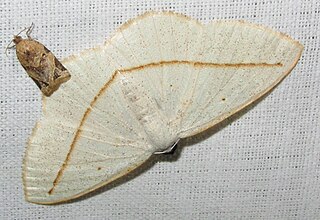
Lomographa inamata is a moth in the family Geometridae first described by Francis Walker in 1860. It is found in Sri Lanka, Japan, China, India and Taiwan.

Scirpophaga incertulas, the yellow stem borer or rice yellow stem borer, is a species of moth of the family Crambidae. It was described by Francis Walker in 1863. It is found in Afghanistan, Nepal, north-eastern India, Sri Lanka, Bangladesh, Myanmar, Vietnam, Thailand, Malaysia, Singapore, Sumatra, Java, Borneo, Sumba, Sulawesi, the Philippines, Taiwan, China and Japan.
Eupterote geminata is a moth in the family Eupterotidae. It was described by Francis Walker in 1855. It is found in India and Sri Lanka.
Brana is a monotypic moth genus of the family Noctuidae. Its only species, Brana calopasa, is found in Sri Lanka and Australia. Both the genus and species were described by Francis Walker, the genus in 1858 and the species in 1859. It It is a serious pest on Berrya cordifolia.
Radara subcupralis is a moth of the family Noctuidae first described by Francis Walker in 1866.
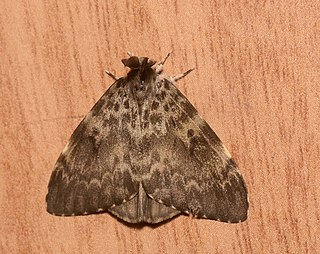
Lymantria ampla is a moth of the family Erebidae first described by Francis Walker in 1855. It is found in India and Sri Lanka.
Hypochrosis chlorozonaria is a moth of the family Geometridae first described by Francis Walker in 1860. It is found in Sri Lanka.

Hypomecis transcissa is a moth of the family Geometridae first described by Francis Walker in 1860. It is found in the Indian subregion and from Sri Lanka to Sundaland.
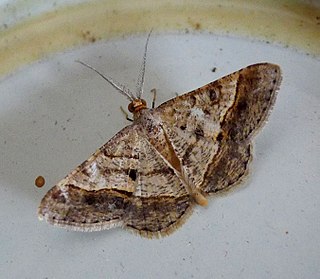
Isturgia pulinda is a moth of the family Geometridae first described by Francis Walker in 1860. The species has a widespread distribution from the African countries of Botswana, Ethiopia, the Gambia, Kenya, Malawi, Mozambique, South Africa, Tanzania, Zambia and Zimbabwe to Saudi Arabia and Yemen towards the Indian subregion and Sri Lanka. In Europe, it is found in the Canary Islands, Spain, Portugal and the Cape Verde Islands.
Mixocera parvulata is a moth of the family Geometridae first described by Francis Walker in 1863. It is found in India, Sri Lanka, Maldives, Vietnam, Ethiopia, Kenya, Madagascar, South Africa, Tanzania and Zimbabwe
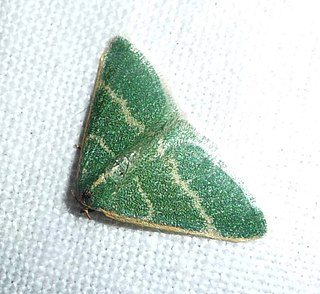
Microloxia herbaria, the herb emerald, is a moth of the family Geometridae. The species was first described by Jacob Hübner in 1808. It is a widespread species that can be found along the Mediterranean region, southern Europe, central Asia towards southern Asia including India, Pakistan and Sri Lanka and to the Russian Far East.
Luxiaria phyllosaria is a moth of the family Geometridae first described by Francis Walker in 1860. It is found in Sri Lanka, the north-eastern Himalayas of India, Sumatra, Borneo, the Philippines and Sulawesi.
Ophthalmitis caritaria is a moth of the family Geometridae first described by Francis Walker in 1860. It is found in Sri Lanka.
Scardamia bractearia is a moth of the family Geometridae first described by Francis Walker in 1860. It is found in Sri Lanka.
Sauris proboscidaria is a moth of the family Geometridae first described by Francis Walker in 1862. It is found in Sri Lanka.
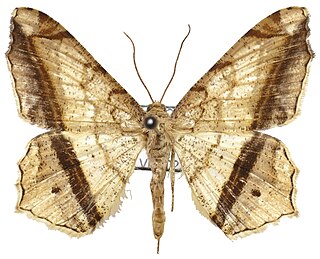
Semiothisa ozararia, is a moth of the family Geometridae first described by Francis Walker in 1860. It is found in the Indian subregion, Sri Lanka, Taiwan, Borneo, Sumatra and Java.
Dysaethria conflictaria, or Epiplema conflictaria, is a moth of the family Uraniidae first described by Francis Walker in 1861. It is found in Indo-Australian tropics of India, Sri Lanka, Thailand, Papua New Guinea, the Solomon Islands and Australia.

Pseudomicronia advocataria is a moth of the family Uraniidae first described by Francis Walker in 1861. It is found in the Philippines, Sundaland, the Andaman Islands, India, Taiwan, South China and Sri Lanka.
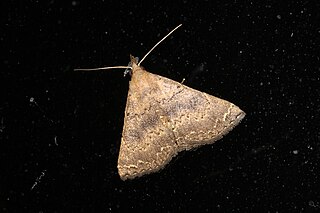
Progonia oileusalis is a moth of the family Noctuidae first described by Francis Walker in 1859. It is found in Sri Lanka, Borneo, India, Taiwan, Japan and the Philippines.
References
- ↑ Beccaloni, G.; Scoble, M.; Kitching, I.; Simonsen, T.; Robinson, G.; Pitkin, B.; Hine, A.; Lyal, C., eds. (2003). "Ruttellerona". The Global Lepidoptera Names Index . Natural History Museum . Retrieved 14 October 2018. Note: This source and two others below use the spelling "Ruttellerona", but the handwritten card uses the spelling "Ruttelerona".
- ↑ "Species Details: Ruttelerona cessaria Walker, 1860". Catalogue of Life. Retrieved 17 March 2018.
- ↑ Koçak, Ahmet Ömer; Kemal, Muhabbet (20 February 2012). "Preliminary list of the Lepidoptera of Sri Lanka". Cesa News. Centre for Entomological Studies Ankara (79): 1–57 – via Academia.
- ↑ "Ruttellerona pseudocessaria[sic] sp. n." The Moths of Borneo. Retrieved 17 March 2018.
- ↑ Savela, Markku. "Ruttellerona cessaria[sic] (Walker, 1860)". Lepidoptera and Some Other Life Forms. Retrieved 14 October 2018.